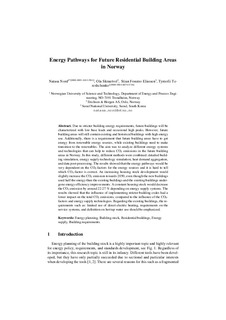| dc.contributor.author | Nord, Natasa | |
| dc.contributor.author | Skrautvol, Ola | |
| dc.contributor.author | Fossmo Eliassen, Stian | |
| dc.contributor.author | Tereshchenko, Tymofii | |
| dc.date.accessioned | 2019-03-05T13:54:00Z | |
| dc.date.available | 2019-03-05T13:54:00Z | |
| dc.date.created | 2018-09-28T10:52:36Z | |
| dc.date.issued | 2019 | |
| dc.identifier.isbn | 978-3-030-00662-4 | |
| dc.identifier.uri | http://hdl.handle.net/11250/2588817 | |
| dc.description.abstract | Due to stricter building energy requirements, future buildings will be characterized with low base loads and occasional high peaks. However, future building areas will still contain existing and historical buildings with high energy use. Additionally, there is a requirement that future building areas have to get energy from renewable energy sources, while existing buildings need to make transition to the renewables. The aim was to analyze different energy systems and technologies that can help to reduce CO2 emissions in the future building areas in Norway. In this study, different methods were combined: detailed building simulation, energy supply technology simulation, heat demand aggregation, and data post-processing. The results showed that the energy pathways would be very dependent on the CO2-factors for the energy sources and it is hard to tell which CO2-factor is correct. An increasing housing stock development would slightly increase the CO2 emission towards 2050, even though the new buildings used half the energy than the existing buildings and the existing buildings undergone energy efficiency improvements. A constant housing stock would decrease the CO2 emission by around 22–27% depending on energy supply systems. The results showed that the influence of implementing stricter building codes had a lower impact on the total CO2 emissions, compared to the influence of the CO2-factors and energy supply technologies. Regarding the existing buildings, the requirements such as: limited use of direct electric heating, requirements on the service systems, and definition on hot tap water use should be emphasized. | nb_NO |
| dc.language.iso | eng | nb_NO |
| dc.publisher | Springer Verlag | nb_NO |
| dc.relation.ispartof | Cold Climate HVAC 2018 - Sustainable Buildings in Cold Climates | |
| dc.title | Energy Pathways for Future Residential Building Areas in Norway | nb_NO |
| dc.type | Chapter | nb_NO |
| dc.description.version | acceptedVersion | nb_NO |
| dc.identifier.doi | 10.1007/978-3-030-00662-4_42 | |
| dc.identifier.cristin | 1615546 | |
| dc.relation.project | Norges forskningsråd: 268248 | nb_NO |
| dc.description.localcode | This is a post-peer-review, pre-copyedit version of an article published in [Springer Proceedings in Energy] Locked until 12.12.2019 due to copyright restrictions. The final authenticated version is available online at: https://doi.org/10.1007/978-3-030-00662-4_42 | nb_NO |
| cristin.unitcode | 194,64,25,0 | |
| cristin.unitname | Institutt for energi- og prosessteknikk | |
| cristin.ispublished | true | |
| cristin.fulltext | postprint | |
| cristin.qualitycode | 1 | |
